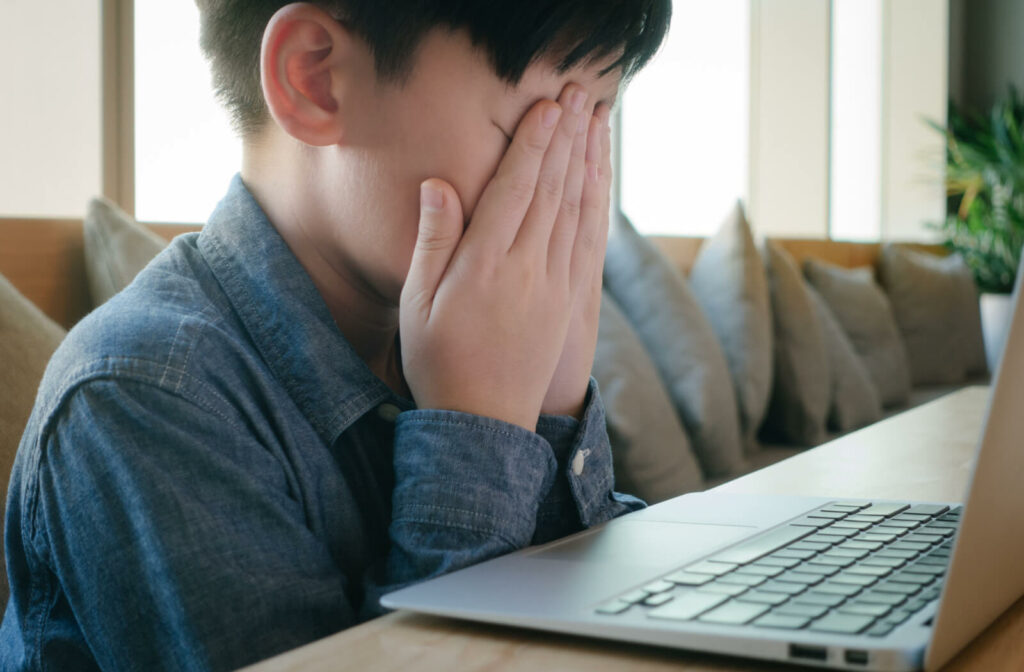In our modern digital world, people spend more and more time using technology for business and pleasure, resulting in hours of screen time. Unfortunately, this also means more people are experiencing digital eye strain. And though technology isn’t the only culprit of eye strain, it is a major cause.
But how long can eye strain last? Eye strain is different for everyone, but it should go away within minutes to hours after ceasing activities involving eye focus.
Regular eye exams can help you find relief from eye strain, and your optometrist may check for signs of dry eye and prescribe eye drops as part of your treatment plan.
What Is Eye Strain?
The eye’s natural focusing system, which we employ for near vision, is all muscular effort. Like anywhere else in the body, eye strain is a tiredness of the muscles from overuse.
The ciliary muscle, which is part of the focusing system of the eye, is a ring-shaped organ that extends from the coloured portion of the eye, the iris. The fluid in the eye, known as aqueous humour, is produced by the ciliary body. It also houses the ciliary muscle, which directly changes the shape of your lens as you concentrate your eyes on a close-up object.
What Causes Eye Strain?
Eye strain is a result of prolonged or excessive use of focused eyesight. Many people spend an increasing amount of time doing close-up activities like reading or using digital devices, which can be detrimental to their eyes.
Activities that cause eye strain include:
- Reading
- Writing
- Driving
- Screen use from any digital device
- Looking at a bright light
- Spending too much time in dim lighting
- Feeling stressed or tired
- In some cases, an undiagnosed eye problem
Other causes of digital eye strain include:
- Having bad posture when using digital devices
- Failing to blink as frequently as necessary
- Holding a digital device too far or too close to your eyes
- Viewing a screen with improperly set lighting

How to Prevent Eye Strain
Oftentimes, simple, noninvasive approaches can alleviate eye strain, however, prolonged eye strain or eye irritation may indicate a more serious problem and should be assessed by your eye doctor.
The 20-20-20 Rule
Eye strain often takes place when you participate in a single task for an extended length of time without taking a break. To give your eyes a short break, every 20 minutes, you can take a 20-second break and focus your eyes on something at least 20 feet away. This is referred to as the 20-20-20 rule.
If you must work at a computer screen or drive a long distance for several hours, for example, balance out those activities with others that require different usage of your eyes. Taking a walk outside in natural lighting, for example, can give your eyes a rest.
Limiting your time spent on a single activity is a simple strategy to avoid eye strain, especially when that activity includes digital devices.
Reposition Your Screen
The position of your screen can have an impact on your eyes. Check that you’re looking at your computer or other technology from an appropriate distance and location. The screen should be roughly an arm’s length away from your eyes. The screen should be at or slightly below the level of your eyes. This also applies to handheld digital devices such as phones and e-readers: you should hold them at or below your eye level.
You can also consider enlargement of the text if you’re reading on a computer, phone, or e-reader.
Finding Correct Lighting for Each Activity
Eye strain can be a result of poor lighting. Depending on the activity, the lighting required for your eyes to focus properly can be either too dark or too bright. If you’re concentrating hard on something, such as reading, the light should come from behind you. When watching TV, dimming the lights may help lessen eye strain.
Using Eye Drops
Part of the reason we experience eye strain while reading or using digital devices is due to reduced blinking. The average person blinks 15 to 20 times per minute, but this number dramatically reduces when staring at a digital screen or reading a book.
Blinking less frequently causes your eyes to become dry and agitated. This can be resolved by using eye drops such as artificial tears. Reminding yourself to blink more frequently when engaging in focused activities may also help alleviate eye strain.
What Else Can You Do About Eye Strain?
By following the preventative tips above, you should be able to lessen the strain on your eyes that comes with focused activities, however, the best thing to do when you’re suffering from the discomfort and irritation that comes from eye strain is to speak with your eye doctor and book an appointment. Whitby Family Eye Care can help provide relief and a treatment plan going forward.







